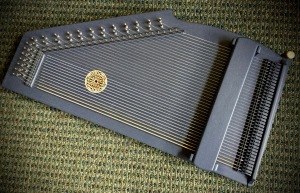 The swarmandal is a plucked box zither of Indian origin and used as an accompanying instrument for the vocal classical music of Northern India. Modern swarmandals are similar to western zithers in shape and construction. In fact, autoharps with the chord bars removed are sometimes used as an equivalent instrument in India today.
The swarmandal is a plucked box zither of Indian origin and used as an accompanying instrument for the vocal classical music of Northern India. Modern swarmandals are similar to western zithers in shape and construction. In fact, autoharps with the chord bars removed are sometimes used as an equivalent instrument in India today.
These past few months I have been working with Purnash, a popular musician and multi-instrumentalist who performs in venues across Asia, the subcontinent, and beyond. We have combined our ideas to reinvent the swarmandal and build a hybrid that he has named “Raagaharp”. Raagaharp has a diatonic tuning schedule in the key of Eb for for his vocal range, and a combination of specially constructed lock bars for the deletion of specific notes within the immense variety of ragas he performs.
I am only familiar with western musical concepts as they apply to folk and old time music. I cannot understand or explain ragas. They are described as improvisations on a construct of modes, scales, and notes, each to affect the emotions of the listener…. and there are hundreds of them!
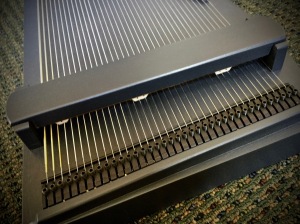 The strings are played open. According to the musician, for a given raga he will mute some notes and re-tune some strings. He does this on-the-fly (imagine doing this between autoharp tunes!). To change the instrument’s setup between ragas, we arrived at the idea of a combination of fine tuners and lock bars.
The strings are played open. According to the musician, for a given raga he will mute some notes and re-tune some strings. He does this on-the-fly (imagine doing this between autoharp tunes!). To change the instrument’s setup between ragas, we arrived at the idea of a combination of fine tuners and lock bars.
 The lock bars of an autoharp function much like their adjoining chord bars… held aloft by springs when not in use and locked down by some sort of a wedge. The swarmandal’s lock bars will be swapped in and out as needed and seated, without springs, against the strings by a magnetic cover.
The lock bars of an autoharp function much like their adjoining chord bars… held aloft by springs when not in use and locked down by some sort of a wedge. The swarmandal’s lock bars will be swapped in and out as needed and seated, without springs, against the strings by a magnetic cover.
The fixture can hold one or two bars at once and also serves as a hand rest. Inlaid in the underside of the cover are two strong magnets for attachment. The cover is easily removed and replaced for changing out the bars.
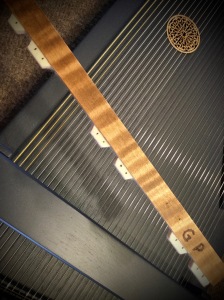 The bars are made of curly maple and felted in combinations of single and double notes. There are only seven notes in the scale but only six different notes will be muted since the keynote, Eb, will always be open. Six different bars are sufficient but I made an additional six bars with double notes.
The bars are made of curly maple and felted in combinations of single and double notes. There are only seven notes in the scale but only six different notes will be muted since the keynote, Eb, will always be open. Six different bars are sufficient but I made an additional six bars with double notes.
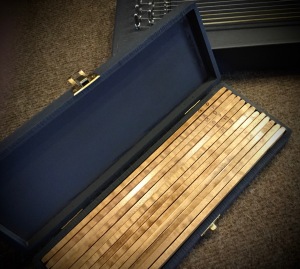 Autoharp chord/lock bars reside on the ‘harp and are seldom removed unless they need attention. The swarmandal’s lock bars will be constantly swapped in and out. To protect the fragile felt blocks I made a case to house the twelve+ bars and included extra felt for future wear.
Autoharp chord/lock bars reside on the ‘harp and are seldom removed unless they need attention. The swarmandal’s lock bars will be constantly swapped in and out. To protect the fragile felt blocks I made a case to house the twelve+ bars and included extra felt for future wear.
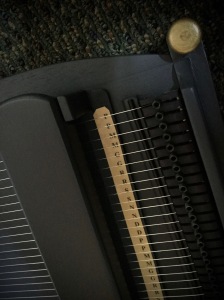 I included my usual tuning strip/duster that can be temporarily inserted underneath the strings as a guide for tuning. The strings are mostly in pairs and tuned to only seven notes. The notes are labeled on the strip and lock bars according to the Indian Solfeggio system….
I included my usual tuning strip/duster that can be temporarily inserted underneath the strings as a guide for tuning. The strings are mostly in pairs and tuned to only seven notes. The notes are labeled on the strip and lock bars according to the Indian Solfeggio system….
Eb is S F is R G is G Ab is M Bb is P C is D D is N
I address musical notes as sharps and naturals from A to G. The completion of this task required some careful translation. For example, a note like Eb to me is D# but on the tuning strip it appears as S.
The musician finds the sound of most swarmandals to be unpleasant and for his custom instrument he requested a warmer, less brilliant sound, particularly in the treble area. I tried to accomplish this with an African mahogany soundboard and by using Delrin rod for the bridge caps. Delrin is a hard plastic material that will render less sustain than the harder brass rod that I usually use.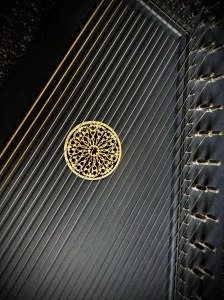
At his request, I applied a matte lacquer finish over a specially formulated Benjamin Moore color called “Hale Navy”. This color seems to appear blue under some lighting and black under others. Obtaining this color in spray form was pricey but the attractive appearance is worth the excessive cost.
I admit, there is little difference between this Indian zither and the autoharps that I have been building over the years. Creating this instrument and listening to Indian music has been a wonderful exposure to Eastern musical culture enabled by an amazing musician and new friend.
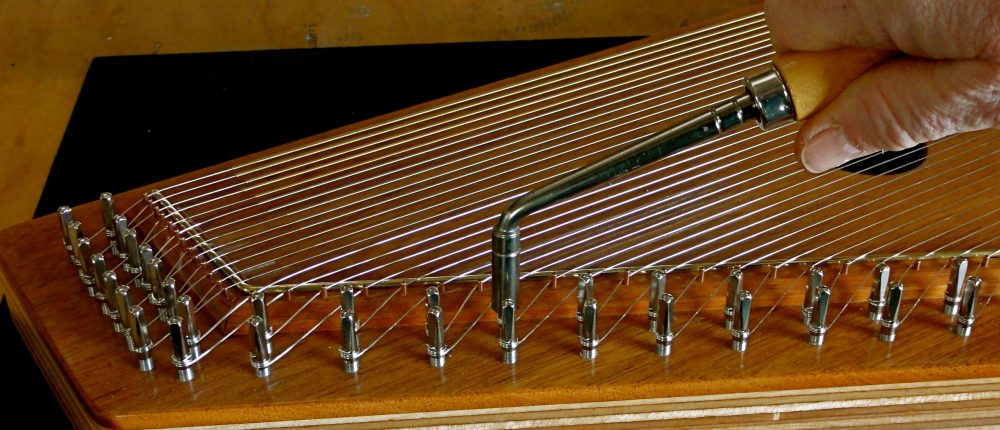
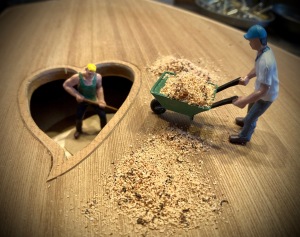 Apertures (sound holes) in stringed musical instruments have been studied, experimented with, and designed for a variety of acoustic functions and characteristics. While a sound hole’s size, shape, and position certainly influence tone and volume, its appearance is what catches the eye and creates a kind of identity.
Apertures (sound holes) in stringed musical instruments have been studied, experimented with, and designed for a variety of acoustic functions and characteristics. While a sound hole’s size, shape, and position certainly influence tone and volume, its appearance is what catches the eye and creates a kind of identity.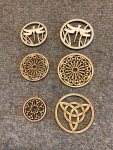
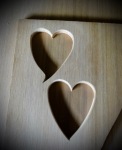
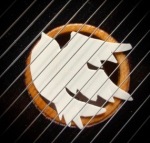



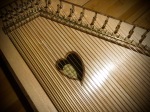
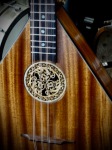


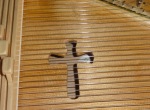
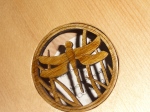
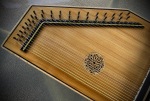
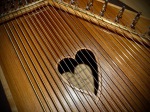
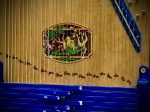

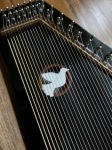

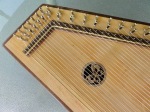

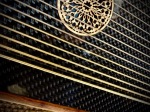

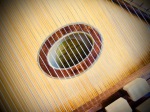
 And a dream it was! As I slept, a small crew (elves?) assisted me with some of the more tedious tasks of autoharp construction. Alas, they had disappeared by morning, never to return. I would like to believe that they responded to some of the many help wanted signs posted in our area and found employment with fair compensation, benefits, and a living wage for their important work.
And a dream it was! As I slept, a small crew (elves?) assisted me with some of the more tedious tasks of autoharp construction. Alas, they had disappeared by morning, never to return. I would like to believe that they responded to some of the many help wanted signs posted in our area and found employment with fair compensation, benefits, and a living wage for their important work.
 I recently completed is this thirty-seven string diatonic autoharp in the single key of A. I built it for ourselves because Marsha and I are trying to sing along with our instruments more and find that the key of A is a comfortable range for our voices. Being a single key diatonic, it has paired string courses in the middle octave and only the notes needed for chords in the key of A. This produces a very rich and full tone that works nicely for strumming accompaniment and playing melody.
I recently completed is this thirty-seven string diatonic autoharp in the single key of A. I built it for ourselves because Marsha and I are trying to sing along with our instruments more and find that the key of A is a comfortable range for our voices. Being a single key diatonic, it has paired string courses in the middle octave and only the notes needed for chords in the key of A. This produces a very rich and full tone that works nicely for strumming accompaniment and playing melody.
 Fifteen chords are arranged in a “Bowers” type setup with major chords in the center row, sevenths in the top row, and minors in the bottom row. This familiar arrangement is in place on all of Marsha’s instruments and permits a sort of “motor memory” to kick in when she changes from one autoharp to another, even if in different keys. Seven of the chords are “color chords” for enhanced arrangements.
Fifteen chords are arranged in a “Bowers” type setup with major chords in the center row, sevenths in the top row, and minors in the bottom row. This familiar arrangement is in place on all of Marsha’s instruments and permits a sort of “motor memory” to kick in when she changes from one autoharp to another, even if in different keys. Seven of the chords are “color chords” for enhanced arrangements. The instrument has a 1/4 inch thick solid spruce soundboard. The one piece frame is laminated maple pinblock with a laminated maple back. The side veneer, end cover, and chord bar covers are made of curly maple. Chord bars are maple with alternate bars painted black. Black tuning pins, bridges, Schreiber fine tuners, and purfling complete the black/white motif.
The instrument has a 1/4 inch thick solid spruce soundboard. The one piece frame is laminated maple pinblock with a laminated maple back. The side veneer, end cover, and chord bar covers are made of curly maple. Chord bars are maple with alternate bars painted black. Black tuning pins, bridges, Schreiber fine tuners, and purfling complete the black/white motif.
 I realize that the title of this post is kind of a stretch but it’s embarrassingly indicative of how my mind sometimes works. “My Name Is Morgan But It Ain’t J.P.” is an old time song that was covered by The New Lost City Ramblers. Mike Seeger, a member of the trio, famously owned and played an autoharp (not on that song) built by Tom Morgan of Morgan Springs, Tennessee. It was in admiration of Mike Seeger’s Morgan autoharp that prompted an Ohio musician to obtain the one I’m about to describe.
I realize that the title of this post is kind of a stretch but it’s embarrassingly indicative of how my mind sometimes works. “My Name Is Morgan But It Ain’t J.P.” is an old time song that was covered by The New Lost City Ramblers. Mike Seeger, a member of the trio, famously owned and played an autoharp (not on that song) built by Tom Morgan of Morgan Springs, Tennessee. It was in admiration of Mike Seeger’s Morgan autoharp that prompted an Ohio musician to obtain the one I’m about to describe. Long story short…. this beautiful instrument arrived in 1980 fully finished but absent the chord bars. For various reasons Mr. Morgan could not complete the chord set but instead sent along sufficient rough stock of Brazilian rosewood for their fabrication. The instrument has slumbered peacefully and unplayed for over forty years until it came to my workshop last October.
Long story short…. this beautiful instrument arrived in 1980 fully finished but absent the chord bars. For various reasons Mr. Morgan could not complete the chord set but instead sent along sufficient rough stock of Brazilian rosewood for their fabrication. The instrument has slumbered peacefully and unplayed for over forty years until it came to my workshop last October. There are several features that make this a very distinctive autoharp. The woods, spruce and Brazilian rosewood, were purchased by Mr. Morgan at auction from the C.F. Martin guitar company where they had been in storage since the 1940s. The one piece spruce soundboard carries two of Morgan’s trademark “f” holes and is carved into a gentle violin- like arch. Although I couldn’t observe them because of the size and location of the sound holes, there apparently exist an internal pre-stressed truss rod and tone bars that, with a stainless steel anchor end reinforcing plate, make this a very stable instrument.
There are several features that make this a very distinctive autoharp. The woods, spruce and Brazilian rosewood, were purchased by Mr. Morgan at auction from the C.F. Martin guitar company where they had been in storage since the 1940s. The one piece spruce soundboard carries two of Morgan’s trademark “f” holes and is carved into a gentle violin- like arch. Although I couldn’t observe them because of the size and location of the sound holes, there apparently exist an internal pre-stressed truss rod and tone bars that, with a stainless steel anchor end reinforcing plate, make this a very stable instrument. Although unplayed, the chromatic string set was forty years old and a little corroded. After much consideration it was decided to replace it with a scale designed for diatonic play in the keys of G and D. An optional F note replaces an F# in the scale to allow an F chord for play in the key of C. The chords were chosen based upon the songs that will be accompanied and extra stock was made into additional minor chords, two lock bars, and blank bars for future need.
Although unplayed, the chromatic string set was forty years old and a little corroded. After much consideration it was decided to replace it with a scale designed for diatonic play in the keys of G and D. An optional F note replaces an F# in the scale to allow an F chord for play in the key of C. The chords were chosen based upon the songs that will be accompanied and extra stock was made into additional minor chords, two lock bars, and blank bars for future need. The twelve, 5/16 inch-wide chord bars are arranged in two rows as was probably the intention of the builder. They rest upon #6 steel pins driven into Delrin bases. The Seeger autoharp bore round buttons that were sometimes broken. These chord bars were fitted with comfortable dished trapezoidal buttons made of rosewood.
The twelve, 5/16 inch-wide chord bars are arranged in two rows as was probably the intention of the builder. They rest upon #6 steel pins driven into Delrin bases. The Seeger autoharp bore round buttons that were sometimes broken. These chord bars were fitted with comfortable dished trapezoidal buttons made of rosewood.
 It was both an honor and a challenge completing this beautiful sounding instrument. Rosewood is a hard and oily wood that was not kind to tools and abrasives. I had some anxiety over making the most use of the limited and irreplaceable chord bar stock that was provided.
It was both an honor and a challenge completing this beautiful sounding instrument. Rosewood is a hard and oily wood that was not kind to tools and abrasives. I had some anxiety over making the most use of the limited and irreplaceable chord bar stock that was provided.
 Finally, after over forty years of initial correspondence with the instrument’s luthier Tom Morgan, weeks of consultation in my workshop, and even a global pandemic, the patient musician and his Morgan autoharp #80002 sing together.
Finally, after over forty years of initial correspondence with the instrument’s luthier Tom Morgan, weeks of consultation in my workshop, and even a global pandemic, the patient musician and his Morgan autoharp #80002 sing together. As a luthier for 40+ years I have built hundreds of dulcimers and a great variety of other stringed instruments. In 2012, my first foray into the blogosphere was titled “Whatshebuildinginthere” in which I wrote about my instrument building with an emphasis on experimentation, information, and encouragement to help other musicians and builders. At some point autoharps took control so in 2016 I began this new blog calling it “fretorfretnot”. I expected to carry on blogging about both fretted and not fretted stringed instruments but again, autoharps ruled. Only lately have I found the time to pound frets instead of tuning pins.
As a luthier for 40+ years I have built hundreds of dulcimers and a great variety of other stringed instruments. In 2012, my first foray into the blogosphere was titled “Whatshebuildinginthere” in which I wrote about my instrument building with an emphasis on experimentation, information, and encouragement to help other musicians and builders. At some point autoharps took control so in 2016 I began this new blog calling it “fretorfretnot”. I expected to carry on blogging about both fretted and not fretted stringed instruments but again, autoharps ruled. Only lately have I found the time to pound frets instead of tuning pins.




 I have always maintained my own instruments, mostly out of economic necessity but especially for the challenging DIY learning experience. This has led to a deeper understanding of what my instruments are capable of and how I might modify them to meet my personal needs. That has led to my forty plus years as a luthier, building and repairing a variety of stringed instruments.
I have always maintained my own instruments, mostly out of economic necessity but especially for the challenging DIY learning experience. This has led to a deeper understanding of what my instruments are capable of and how I might modify them to meet my personal needs. That has led to my forty plus years as a luthier, building and repairing a variety of stringed instruments. Plans for the Schmidt Model 73 are available for purchase from the Guild Of American Luthiers.
Plans for the Schmidt Model 73 are available for purchase from the Guild Of American Luthiers. Musicmakers offers a free download of plans and assembly instructions for their long discontinued “Autochord” kit and continues to sell the collated hardware to complete it. The Autochord differs somewhat in size and construction from other ‘harps but offers many helpful ideas. The file can be enlarged to full size at a retail copy center.
Musicmakers offers a free download of plans and assembly instructions for their long discontinued “Autochord” kit and continues to sell the collated hardware to complete it. The Autochord differs somewhat in size and construction from other ‘harps but offers many helpful ideas. The file can be enlarged to full size at a retail copy center. The Autoharp Owner’s Manual includes excellent plans and instructions for building
The Autoharp Owner’s Manual includes excellent plans and instructions for building The best framing material for tuning and overall stability is the multi-laminated maple pin block manufactured for pianos. It grips tuning pins without cracking and remains stable in changing environmental conditions. It is particularly effective when cut as a single unit for the angled treble side, as it eliminates a troublesome joint that wants to creep. I like to cut the entire frame from a single blank so that there are no joints to fail. Pin block can be obtained from a piano technician or piano supply but the planks are fifty-nine inches long, so it’s unlikely that they would sell only enough for one ‘harp. Contact me to purchase a more economical size.
The best framing material for tuning and overall stability is the multi-laminated maple pin block manufactured for pianos. It grips tuning pins without cracking and remains stable in changing environmental conditions. It is particularly effective when cut as a single unit for the angled treble side, as it eliminates a troublesome joint that wants to creep. I like to cut the entire frame from a single blank so that there are no joints to fail. Pin block can be obtained from a piano technician or piano supply but the planks are fifty-nine inches long, so it’s unlikely that they would sell only enough for one ‘harp. Contact me to purchase a more economical size. Since introducing my new twenty-three string, seven chord child size autoharps two months ago, I received a lot of interest and positive comments. My goal was to produce a serious instrument for the young learner to play while growing into a standard, full size autoharp. I guess I wasn’t too surprised when several adults found them to be a good size as a travel instrument or for someone challenged by the size and weight of a more standard autoharp. At only eighteen inches long and weighing only four and one-half pounds, they are easy to hold and carry.
Since introducing my new twenty-three string, seven chord child size autoharps two months ago, I received a lot of interest and positive comments. My goal was to produce a serious instrument for the young learner to play while growing into a standard, full size autoharp. I guess I wasn’t too surprised when several adults found them to be a good size as a travel instrument or for someone challenged by the size and weight of a more standard autoharp. At only eighteen inches long and weighing only four and one-half pounds, they are easy to hold and carry.


 Several years ago they produced their version of an autoharp and called it an “Autochord”. It was a unique design that differed from the more conventional Chromaharps and Oscar Schmidts. Thirty-eight ball end guitar strings spanned from bridge pins to an anchor end bridge made from a section of brass tubing. The chromatic tuning was scheduled from F2 to A5. The fifteen chord bars rested upon 1/8 Delrin rods drilled directly into the soundboard. The body of the instrument consisted of a 1/4″ redwood soundboard with a bass bar, a 3/8″ plywood back, and a laminated frame with gaps at each end of the long rail.
Several years ago they produced their version of an autoharp and called it an “Autochord”. It was a unique design that differed from the more conventional Chromaharps and Oscar Schmidts. Thirty-eight ball end guitar strings spanned from bridge pins to an anchor end bridge made from a section of brass tubing. The chromatic tuning was scheduled from F2 to A5. The fifteen chord bars rested upon 1/8 Delrin rods drilled directly into the soundboard. The body of the instrument consisted of a 1/4″ redwood soundboard with a bass bar, a 3/8″ plywood back, and a laminated frame with gaps at each end of the long rail. This interesting instrument was offered as an easy to assemble kit for someone with basic DIY skills. Like all of Musicmakers kits, it would, with attention to detail, bring satisfying results. The result however, was a rather large, heavy, and somewhat unconventional autoharp.
This interesting instrument was offered as an easy to assemble kit for someone with basic DIY skills. Like all of Musicmakers kits, it would, with attention to detail, bring satisfying results. The result however, was a rather large, heavy, and somewhat unconventional autoharp. This Autochord kit came to my workshop in the original shipping carton. It was purchased in 1995 and had only the soundboard and back glued to the frame. The current owner asked me to complete it and install fine tuners.
This Autochord kit came to my workshop in the original shipping carton. It was purchased in 1995 and had only the soundboard and back glued to the frame. The current owner asked me to complete it and install fine tuners. I made several modifications to the original design. The Daigle fine tuner system came with its own bridge so I deleted the kit’s brass tube. The wound bass strings supplied were standard guitar strings that had windings their entire length. Greg Schreiber made a custom set of wound strings that had windings only within the speaking length of the strings. I substituted threaded adjustable bridge pins so I could accurately level the strings for effective damping.
I made several modifications to the original design. The Daigle fine tuner system came with its own bridge so I deleted the kit’s brass tube. The wound bass strings supplied were standard guitar strings that had windings their entire length. Greg Schreiber made a custom set of wound strings that had windings only within the speaking length of the strings. I substituted threaded adjustable bridge pins so I could accurately level the strings for effective damping. The design specified drilling the Delrin chord bar combs directly into the soundboard. Instead, I made separate Delrin bases that can be more easily adjusted for smoother chord bar movement.
The design specified drilling the Delrin chord bar combs directly into the soundboard. Instead, I made separate Delrin bases that can be more easily adjusted for smoother chord bar movement. With that in mind, I present my own iteration of a child size autoharp designed as a serious, good sounding, and well built instrument for the young learner. I believe that a quality, attractive, and stable instrument with standard string spacing, and a logical chord bar setup will make it easier to learn and to later grow into a standard autoharp. My aim is to produce a smaller scale instrument for fun as well as serious study and not a colorful toy of passing interest.
With that in mind, I present my own iteration of a child size autoharp designed as a serious, good sounding, and well built instrument for the young learner. I believe that a quality, attractive, and stable instrument with standard string spacing, and a logical chord bar setup will make it easier to learn and to later grow into a standard autoharp. My aim is to produce a smaller scale instrument for fun as well as serious study and not a colorful toy of passing interest.

 The high quality Schreiber custom string set is specially gauged for a string schedule tuned: G-C-F-G-A-B-C-D-E-F-G-A-A#-B-C-D-E-F-G-A-A#-B-C.
The high quality Schreiber custom string set is specially gauged for a string schedule tuned: G-C-F-G-A-B-C-D-E-F-G-A-A#-B-C-D-E-F-G-A-A#-B-C.
 At this time the only option I can offer is the choice of woods for the side veneer, chord set, bridges, and end cover. This prototype is cherry but other choices include walnut, maple, and mahogany. In the future I plan to add greater customization and alternate chord setups with more chords in two or three rows.
At this time the only option I can offer is the choice of woods for the side veneer, chord set, bridges, and end cover. This prototype is cherry but other choices include walnut, maple, and mahogany. In the future I plan to add greater customization and alternate chord setups with more chords in two or three rows.
You must be logged in to post a comment.